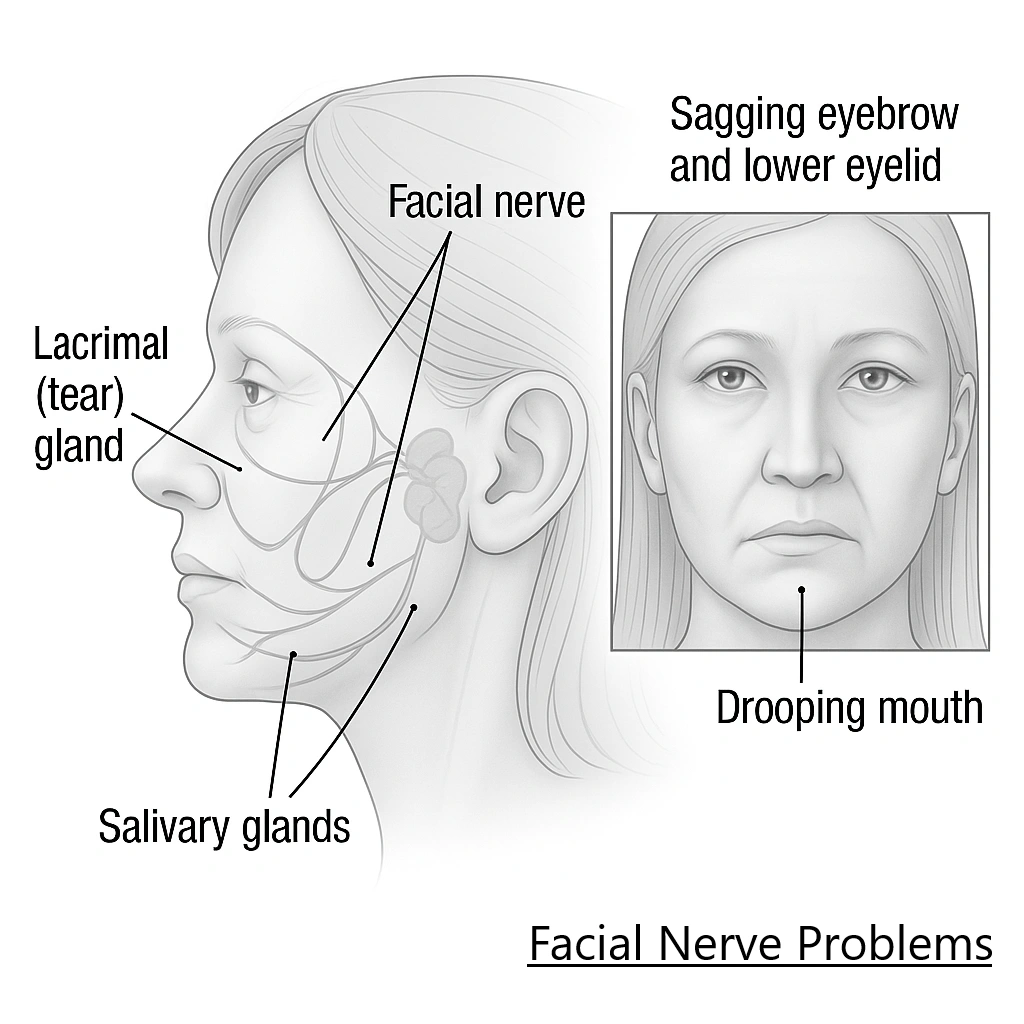
Twitching, weakness, or paralysis of the face is a symptom of some disorder involving the facial nerve. It is not a disease in itself. The disorder may be caused by many different diseases, including infection, injury, or treatment.
Function Of The Facial Nerve
The facial nerve resembles a telephone cable and contains 7,000 individual nerve fibers. Each fiber carries electrical impulses to a specific facial muscle. Acting as a unit, this nerve allows us to laugh, cry, smile, or frown, hence the name, "the nerve of facial expression."
When half or more of the individual nerve fibers that make up the facial nerve are interrupted, facial weakness is noted. If these nerve fibers are irritated, then abnormal movements of the facial muscles appear as spasms or twitching of the face.
The facial nerve not only carries nerve impulses to the muscles of the face, but also carries nerve impulses to the tear glands, the salivary glands, the muscle of a small bone in the middle ear (the stapes), and transmits taste fibers from the front of the tongue.
Since the function of the facial nerve is so complex, many symptoms may occur when the fibers of the facial nerve are disrupted. A disorder of the facial nerve may result in twitching, weakness, or paralysis of the face, dryness of the eyes or mouth, or disturbance of taste.
An otolaryngologist-head and neck surgeon/ ent surgeon in Hyderabad is called upon to manage facial nerve problems because of the close association of this nerve with the ear structures.

After leaving the brain, the facial nerve enters the temporal bone (ear bone) through a small bony tube (the internal auditory canal) in very close association with the hearing and balance nerves.
Along its inch-and-a-half course through a small bony canal in the temporal bone, the facial nerve winds around the three middle ear bones, in the back of the eardrum, and then exits through the mastoid (the bony area behind the part of the ear that is visible).
After the facial nerve leaves the mastoid, it divides again into many branches that supply the various facial muscles. The facial nerve gives off many branches as it courses through the temporal bone: to the tear gland, to the stapes muscle, to the tongue, and to the saliva glands.
Diagnosis, Prognosis, And Treatment Of Facial Nerve Disorders
The three questions most often asked by the patient with a problem in facial nerve function are:
(1) What is the cause? (Diagnosis)
(2) When can I expect recovery? (Prognosis)
(3) What can be done to bring about recovery at the earliest possible moment? (Treatment).
In order to answer these three questions, the otolaryngology-head and neck surgeon must perform an extensive evaluation of each patient to determine the cause of the disorder and to attempt to localize the area of.the facial nerve that is involved so that the best treatment can be prescribed.
Diagnosis
The most common cause of facial weakness that comes on suddenly is referred to as "Bell's palsy." This disorder is thought to be due to the body's response to a particular virus: in reaction to the virus, the facial nerve within the ear bone swells, and this pressure on the nerve in the ear canal damages it.
To be sure that this is the cause of the facial weakness, and that it is not due to some rare cause or other disease, a special set of questions will be asked. The patient will be examined, and a series of tests may be performed. The most common tests are:
Hearing Test: Tests of hearing are done to determine if the damage to the nerve has involved the delicate hearing mechanism.
Balance Test: Balance tests may be needed to determine if the balance nerve is involved.
Tear Test: A test of the eye's ability to produce tears may help the physician determine the location and severity of facial nerve disease
Taste Test: A taste test may be beneficial in locating the affected area of .the facial nerve.
Salvation Test: A saliva flow test may be administered; this test may help predict the location and severity of facial nerve involvement.
X-Rays: X-rays may be obtained to determine if there is an infection, tumor, bone fracture, or other abnormality in the area where the facial nerve lies.
Electrical Test: The facial nerve is stimulated in some cases to determine the severity of involvement. This test may have to be repeated daily to detect progression of the disease.
Prognosis
After the evaluation has been completed, the most likely cause of the facial nerve disorder may become clear, and the second question, "When can I expect recovery to begin," can be answered. This will be discussed by your physician.
Treatment
Not all facial nerve problems require specific treatment. Many will recover spontaneously. Occasionally, however, medical physical therapy or surgical treatment may be necessary. Physical therapy to maintain muscle tone during nerve recovery is often of value.
The most serious complication that may develop as a result of total facial nerve paralysis is an ulcer of the cornea (the clear covering) of the eye. Therefore, it is most important that the eye on the involved side be protected from this complication.
Closing the eye with your finger is an effective way to keep it moist. You should use the back of your finger rather than the tip to ensure that your eye is not injured.
Glasses should be worn whenever you are outside. This will help prevent dust particles from becoming lodged in the eye.
If the eye is dry, you may be advised to use artificial tears.The drops should be used as often as necessary to keep your eye moist.
This may require placing one or two drops in the affected eye every hour while you are awake, and placing ointment in your eye at bedtime.
If you're experiencing facial twitching, weakness, or any signs of facial nerve issues, don't wait. Consult the trusted specialists at Dr Deenadayals ENT Care Centre for expert diagnosis and compassionate care tailored to your needs.